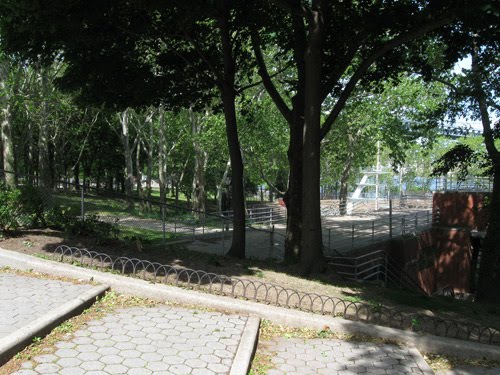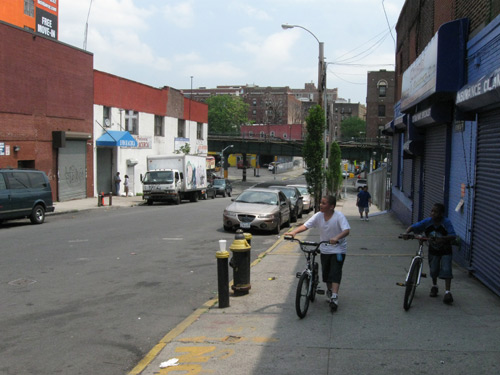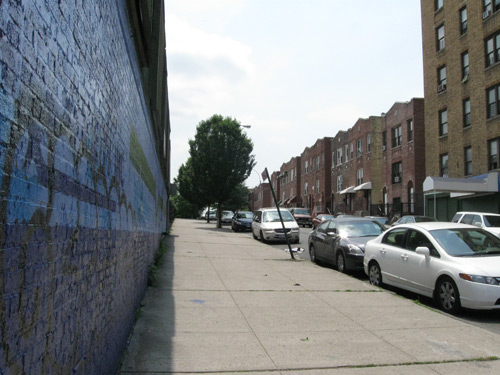
So over the past few weekends, my director of photography Ben Wolf and I have been hitting the pavement. Starting in Astoria, jumping down to LIC and Greenpoint, and finally hitting some major paydirt in the Bronx, we’ve been taking in the sights and sounds of NYC.
We’re looking for a side of New York that isn’t often seen. Our everyday experience of New York, especially of Manhattan, is of a very close horizon with tall buildings and not much in the way of sky. This first image, shot in Astoria, is of the Hellgate Bridge. The vines growing up the supports help beautify the bridge, and the slight incline allows for a dramatic view. There’s also a good contrast between the enormity of the bridge and the small (two-to-three story) houses next and under it.


The next couple of pictures, also taken in Astoria, show some nice diversity as well. The parking lot/alley, while generic in some respects, is broken up by the trees poking through the fence. And the park (Astoria Park) has several meandering paths and a nice incline. This allows for some good foreground/background blocking, creating depth in the frame.
The Bronx
The Bronx offers a “hilly” landscape, featuring a mix of residential and commercial buildings, lots of sky (a good lighting source, as well as a nice break from skyscrapers), and constant activity. The incline allows for some blocking opportunities that can create depth in the frame. The wide sidewalks are a big boon, since they will allow us to do profile shots without having to walk in the street. Many of the scenes take place on a “street vendor” corner, which means we need room for the camera, passersby, vendors with folding tables, and customers.
I’m also looking for a few other things in a good location:
Access to holding: Industrial landscapes and abandoned buildings are beautiful, except when you have to go to the bathroom or eat lunch, change wardrobe, or go somewhere to be quiet. I usually try to make a deal with the nearest church/synagogue/temple/mosque, community center, or hotel/motel.
Power: This is mostly for interiors. Gaffers usually love bringing along a generator and distribution, but on a low budget, it’s impractical. Tie-ins or “plug-and-pray” are your better bet. Look out for tie-in-proof boxes (where they’ve sealed the distribution box cover so you can’t get at the leads), old wiring, or 10 amp circuits (I still see some of these in old apartments).
Noise: The only downside of the part of the Bronx we saw was that we were only two or three blocks away from the elevated 4 train, and there was a tremendous amount of car and pedestrian traffic. We were there on Saturday, however; I’m going back during the week at some point to see how bad it is. The subway is on a somewhat predictable schedule and may be far enough away. Or we will have to decide to use it as part of the mix.
There’s a lot of construction in Astoria, though not as much directly under the bridge. The Hellgate only sees the occasional freight or Amtrak train.
Goods: How far away are you from the nearest hardware store, supermarket, office supply place, and copy center. The last one is especially important at the end of the day when it’s time to distribute callsheets.
Emergency: I worked on a film last year up in the Catskills that only had a part-time medical center in the nearest town. The closest full-on hospital was a good 30-to-45 minute drive. This was a little scary. On the other hand, the State Trooper barracks wasn’t far away, and the volunteer fire department was fairly close by. The nearest snowplow and towing services were down the road.
If you’re in the city, you can sometimes walk or drive faster to the nearest emergency ward than if you wait for the ambulance. So at least learn where the nearest fire/police/hospitals are.
Breakfast and Lunch: I usually try to find a variety of diners, restaurants, delis, etc. nearby so I can either send everyone away for walk-aways, or make deals for catering. It’s almost always better to contract a local business for catering (they won’t get lost, for one thing), but it’s important that they understand the differences between Kosher/Halal, vegetarian and vegan cuisine. Astoria has a ton of restaurants. We spotted a number of good choices in East Burnside (the Bronx).
Public Transportation: Astoria is dependent on the N train and a couple of buses, while you have more options in Burnside.
Parking: No matter how hard you try, you’ll end up with more vehicles than you’d like. If you have a shooting permit that gives you street parking (as opposed to “parking as available”) AND you’ve coned out your parking the night before, you CAN technically ask for a tow service. But do you really want to piss off your temporary neighbors? Sometimes its better politics to find a cheap nearby garage.
Time To Location: A long commute will either be on the clock, or at least impact the turnaround, resulting in a “creeping call.” It will also eat up gas and toll money (all non-production-value-enhancing costs). So shoot locally whenever possible.
Well, that’s it for now – more scouting to do. Now that the rewrite of the script is done (finally), I have to break it down for the next draft of the schedule, and start thinking about interiors, props, and wardrobe concerns.




